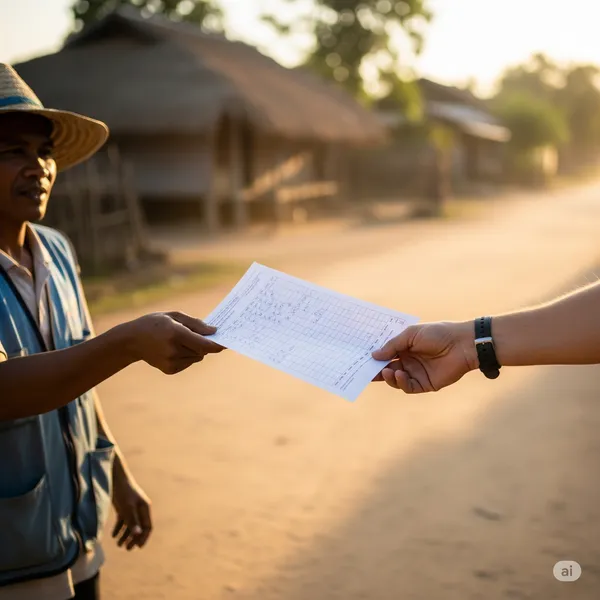Verification with Purpose
Published on: Tue Mar 17 2020 by Ivar Strand
Verification with Purpose: Integrating Accountability and Adaptive Learning
Third-party verification in development and humanitarian programs is typically driven by two distinct imperatives. Donors require it for accountability and fiduciary assurance—to confirm that funds are spent as intended and that contractual obligations are met. Implementing partners, on the other hand, need timely, relevant feedback to enable adaptive management—to understand what is working, what is not, and how to course-correct in dynamic operating environments.
These two objectives, accountability and learning, are often treated as separate, even conflicting, functions. This can lead to parallel systems: one for formal compliance reporting and another, often informal, for actual project management. The key problem is how to design a single verification system that serves both purposes simultaneously, providing rigorous, independent assurance while generating actionable insights that improve project performance.
This paper outlines a model for integrating these functions, transforming verification from a compliance burden into a strategic asset.
The False Dichotomy of Verification
The perceived conflict between accountability and learning stems from their different orientations.
- Accountability-focused verification is primarily summative and backward-looking. It asks: “Were the activities completed as planned? Were resources used appropriately?” The audience is the donor, and the primary concern is mitigating fiduciary and reputational risk. This can create a culture where implementers are hesitant to report challenges for fear of being perceived as underperforming.
- Learning-focused verification is formative and forward-looking. It asks: “Are we achieving the desired effects? Is our underlying theory of change valid? What must we change to be more effective?” The audience is the project management team, and the primary concern is programmatic impact. This requires transparency and a willingness to discuss setbacks openly.
When a single verification system is designed exclusively for accountability, it often fails to generate the timely, nuanced feedback required for learning. Conversely, a system designed purely for learning may lack the structure and impartiality required to provide credible assurance to donors.
Principles for a Unified Verification System
To bridge this divide, a verification system must be intentionally designed to serve both objectives. This requires adherence to a set of core principles.
- A Shared Definition of Success. The process must begin with a clear, mutual understanding of project objectives between the donor and the implementing partner. The verification framework, including key questions and indicators, should be developed against these shared goals, ensuring that what is measured is important to both parties.
- Differentiated Feedback Loops. Information does not need to be reported to all stakeholders at the same speed. An effective system operates on two tracks: a fast, informal loop for learning, and a slower, formal loop for accountability. This allows for rapid operational adjustments without waiting for a formal reporting cycle.
- A Focus on “Why,” Not Just “What.” A purely compliance-based approach documents what happened. An integrated approach investigates why it happened. Understanding the root causes of successes and failures—be they contextual, logistical, or strategic—is what generates actionable knowledge and provides crucial context for accountability reporting.
- Constructive and Objective Framing. The role of the independent monitor is that of a critical friend, not an auditor. Findings should be presented as objective, evidence-based observations intended for joint problem-solving. This framing helps build trust and encourages transparent dialogue between the implementer and the donor.
Putting It into Practice: The Integrated Verification Loop
A practical model for this integrated approach can be structured as a continuous loop.
- Step 1. Co-design of Key Questions. At the outset, the donor, implementer, and monitor collaborate to define a set of Key Verification Questions (KVQs) that address both accountability requirements and learning priorities.
- Step 2. Independent Data Collection. The monitor gathers data from multiple sources (e.g., site visits, beneficiary interviews, remote sensing) specifically to answer the KVQs.
- Step 3. The Learning Loop (Short-Cycle Feedback). The monitor provides frequent, informal feedback directly to the implementer’s project team. This could take the form of brief memos, short calls, or workshops focused on operational challenges and opportunities. At Abyrint, we facilitate these sessions to help teams interpret data and identify immediate course corrections.
- Step 4. The Accountability Loop (Structured Reporting). On a periodic basis (e.g., quarterly), the monitor synthesizes and validates the findings into a formal report for the donor. Crucially, this report not only presents an objective assessment against targets but also documents the “why” behind performance and describes the adaptations the implementer has made based on the learning loop. This demonstrates responsible and adaptive management to the donor.
This two-track approach is visualized in the exhibit below.
Exhibit A: The Integrated Verification Model (A conceptual diagram shows a central “Independent Data Collection & Analysis” process. An arrow points from this process to a small, rapidly-circulating inner loop labeled “Learning Loop,” which connects the “Monitor” and the “Implementer” for “Rapid Feedback & Course Correction.” A second, larger arrow points from the central process to a slower outer loop labeled “Accountability Loop,” which delivers “Formal Reports & Strategic Oversight” to the “Donor.” An arrow shows that insights from the Learning Loop inform the content of the Accountability Loop.)
Beyond Compliance: Verification as a Strategic Asset
Designing verification systems with this dual purpose moves the function beyond a simple check-box exercise. It reframes verification as a strategic investment in program quality and effectiveness. This approach does not eliminate the inherent tension between oversight and management, but it provides a structured process for navigating it productively.
By providing rigorous assurance to donors while delivering actionable insights to implementers, this integrated model fosters a more effective and transparent partnership. Ultimately, it allows development and humanitarian resources to be deployed more intelligently, leading to better outcomes in the complex environments where they matter most.



